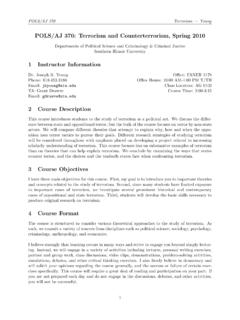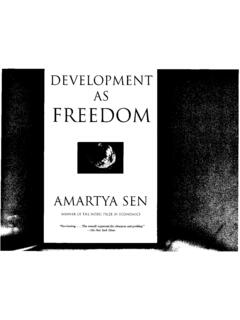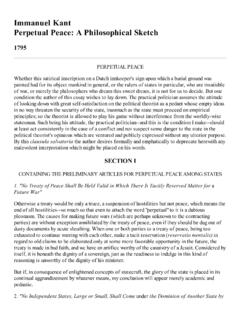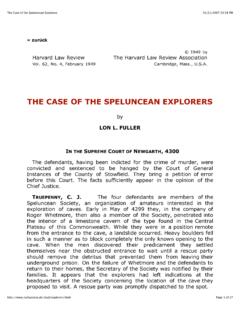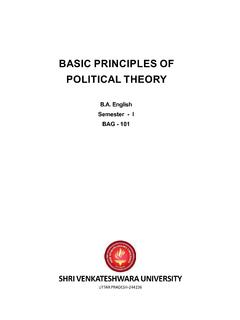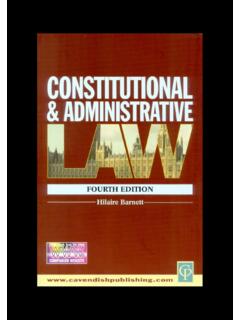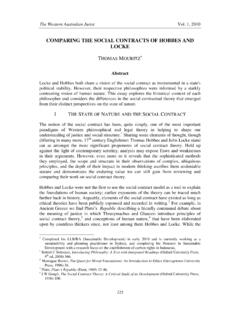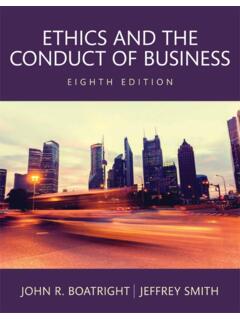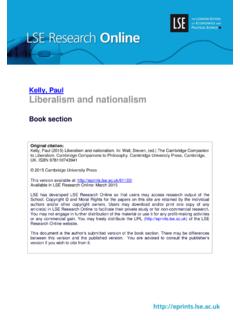Transcription of Justice as Fairness - American University
1 Justice as Fairness A RESTATEMENT John Rawls Edited by Erin Kelry THE BELKNAP PRESS of HARVARD University PRESS Cambridge, Massachusetts London, England 2001 Contents Editor's Foreword Preface . PART I Fundamental Ideas 1. Four Roles of Political Philosophy 2. Society as a Fair System of Cooperation S. The Idea of a Well-Ordered Society 4. The Idea of the Basic Structure s. Limits to Our Inquiry 6. The Idea of the Original Position 7. The Idea of Free and Equal Persons 8. Relations between the Fundamental Ideas g. The Idea of Public Justification 1O. The Idea of Reflective Equilibrium ll. The Idea of an Overlapping Consensus PART II Principles of Justice xz xv 1 1 5 8 10 12 14 18 24 26 29 32 39 12. Three Basic Points 39 lS. Two Principles of Justice 42 14. The Problem of Distributive Justice 50 lS. The Basic Structure as Subject: First Kind of Reason 52 16. The Basic Structure as Subject: Second Kind of Reason 55 VIII 17.
2 Who Are the Least Advantaged? 18. The Difference Principle: Its Meaning 19. Objections via Counterexamples 20. Legitimate Expectations, Entitlement, and Desert 21. On Viewing Native Endowments as a Common Asset 22. Summary Comments on Distributive Justice and Desert Contents 57 61 66 72 74 77 PART III The Argument from the Original Position 80 23. The Original Position: The Set-Up 80 24. The Circumstances of Justice 84 25. Formal Constraints and the Veil of Ignorance 85 26. The Idea of Public Reason 89 27. First Fundamental Comparison ~f',""'v,,\t ~\ ~'l!:y ~\0.~'\ 94 28. The Structure of the Argument and the Maximin Rule 97 29. The Argument Stressing the Third Coildition lOl 30. The Priority of the Basic Liberties 104 31. An Objection about Uncertainty lO6 32. The Equal Basic Liberties Revisited III 33 The Argument Stressing the Second Condition \o~ ll5 34. Second Fundamental Comparison: Introduction \;,,"~.
3 H~\ .f>\~'~ 119 .J'\\'''''' 35. Grounds Falling under Publicity ..) 120 36. Grounds Falling under Reciprocity 122 37. Grounds Falling under Stability 124 38. Grounds against the Principle of Restricted Utility 126 39. Comments on Equality 130 40. Concluding Remarks 132 PART IV Institutions of a Just Basic Structure 135 41. Property-Owning Democracy: Introductory Remarks 135 42. Some Basic Contrasts between Regimes 138 43. Ideas of the Good in Justice as Fairness 140 44. Constitutional versus Procedural Democracy 145 45. The Fair Value of the Equal Political Liberties 148 46. Denial of the Fair Value for Other Basic Liberties 150 47. Political and Comprehensive Liberalism: A Contrast 153 48. A Note on Head Taxes and the Priority of Liberty 157 49: Economic Institutions of a Property-Owning Democracy 158 Contents 50. The Family as a Basic Institution 51. The Flexibility of an Index of Primary Goods 52.
4 AddressingMarx's Critique of Liberalism 53. Brief Comments on Leisure Time PART V The Question of Stability 54. The Domain of the Political 55. The Question of Stability 56. Is Justice as Fairness Political in the Wrong Way? 57. How Is Political Liberalism Possible? 58. An Overlapping Consensus Not Utopian 59. A Reasonable Moral Psychology 60. The Good of Political Society Index ix 180 180 184 188 189 192 195 198 203 Editor's Foreword In a theory of Justice (1971),John Rawls proposed a conception of Justice that he called ' Justice as Fairness ."! According to Justice as Fairness , the most reasonable principles of Justice are those that would be the object of mutual agreement by persons under fair conditions. Justice as Fairness thus develops a theory of Justice from the idea of a social contract . The princi-ples it articulates affirm a broadly liberal conception of basic rights and lib-erties, and only permit inequalities in wealth and income that would be to the advantage of the least well off.
5 In ' Justice as Fairness : Political Not Metaphysical" (1985), Rawls began to develop the idea that an account of Justice with liberal content is best un-derstood as a political A political conception of Justice is justi-fied by reference to political values and should not be presented as part of a more "comprehensive" moral, religious, or philosophical doctrine. This idea is central to Political Liberalism (1993).3 Under the political and social conditions of free institutions, we encounter a plurality of distinct and in-compatible doctrines, many of which are not unreasonable. Political liberal-ism acknowledges and responds to this "fact of reasonable pluralism" by showing how a political conception can fit into various and even conflicting comprehensive doctrines: it is a possible object of an overlapping consen-sus between them. 1. a theory of Justice (Cambridge, Mass.: Harvard University Press, 197!; rev.)
6 Ed., 1999). 2. ': Justice as Fairness : Political Not Metaphysical," Philosophy and Public AffaiTS 14 (Summer 1985): 223-252. 3. Political Liberalism (New York: Columbia University Press, 1993). XlI Editor's Foreword Developing the idea of political liberalism has led Rawls to reformulate his presentation and defense of Justice as Fairness . Whereas a theory of Justice presented Justice as Fairness as part of a comprehensive liberal out-look, this restatement shows how it can be understood as a fo'rm of political liberalism. Indeed, Rawls presents Justice as Fairness as the most reasonable form of political liberalism. In doing so, he recasts the basic arguments for the two principles of Justice that are central to a conception of Justice as Fairness . This book originated as lectures for a course on political philosophy that Rawls taught regularly at Harvard in the 1980s. The course included a study of the works of historically important figures (Hobbes, Locke, Rous-seau, Kant, Hegel, Mill, and Marx) and also presented the fundamentals of Rawls's own view.
7 The lectures on Justice as Fairness were distributed to the class in written form, at first to supplement reading assignments from a theory of Justice . They addressed questions not taken up in theory , and corrected what Rawls had come to see as mistakes in some of theory 's ar-guments. Later the lectures'were presented on their own, as a more or less complete restatement of the theory of Justice as Fairness . By 1989 the manu-script had evolved into something close to its current form. Rawls did revise the manuscript again in the early 199QS as he cQmpleted Political Liberalism. It is not, however, substantially different from the 1989 vt(rsion, except for the addition of 50 on the family. After the publication of Political Liberalism, Rawls turned his attention to a number of other works, including The Law of Peoples, 4 which was originally to be Part VI of this restatement. The rest, now published, are "Reply to Habermas," an in-troduction to the paperback edition of Political Liberalism, and "The Idea of Public Reason Revisited.)
8 "5 Ideas from those works are found here, though not always as fully developed as in their already published form. Because of illness, Rawls has been unable to, rework the manuscript in its final state, as he had planned. Still, most of the manuscript was nearly com-plete. Parts IV and V are the most unfinished, and with more time, surely Rawls would have filled out those sections and integrated them more fully with the first three parts. Part IV reads as addenda to the more detailed and 4 The Law of Peoples (Cambridge, Mass.: Harvard University Press, 1999). 5 "Reply to Habermas," Journal of Philosophy 92 (March 1995): 132-180, reprinted in the paperback edition of Political Liberalism (1996); "The Idea of Public Reason Re-visited," University of Chicago Law Review 64 (Summer 1997): 765-807, reprinted in Col-lected Papers, ed. Samuel Freeman (Cambridge, Mass.: Harvard University Press, 1999) and in The Law of Peoples.
9 ' Editor's Foreword XIII free-standing Parts I-III. Part V is a preliminary effort to reformulate the ar-guments for the stability of Justice as Fairness that were presented in Part Three of a theory of Justice . Using the notion of an overlapping consen-sus, Part V argues for the stability of Justice as Fairness as a political concep-tion of Justice , an idea pursued in Political Liberalism and the more recent works. Although they are unfinished, Parts IV and V present important pieces of the overall argument for Justice as Fairness . The editorial decision has been to leave the!l1' as well as the other parts of the book, mostly un-touched. Some sections were reordered so as to introduce basic distinc-tions earlier. What is now 42 originally followed 50, 47 followed 44, 55 and 57 were reversed, and 56, which had been the last section of Part V, has been inserted between them. Additional changes involved the following.
10 References to Part VI, "The Law of Peoples," have been removed. Some exposition of basic concepts, such as the veil of ignorance, has been added. Where this was done, the wording was drawn from a theory of Justice and Political Liberalism, and footnotes to those works have been added accordingly and bracketed. Throughout, the approach to making changes has been conservative. Revi-sions were kept to a minimum and care has been taken not to alter tlle sub-stance of what Rawls wrote. All changes were made with the author's knowledge. I am grateful for the help I received in preparing this manuscript. I would especially like to acknowledge Joshua Cohen and Mard Rawls, both of whom worked through the text with me in detail. Their critical judgment and numerous suggestions were extremely valuable. For their useful ad-vice, I would also like to thank Arnold Davidson, Barbara Herman, Percy Lehning, Lionel McPherson, and T.



